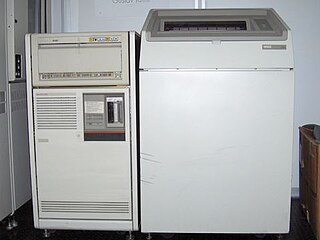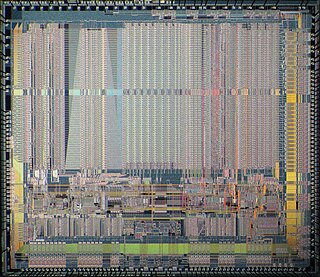
The Pentium II brand refers to Intel's sixth-generation microarchitecture ("P6") and x86-compatible microprocessors introduced on May 7, 1997. Containing 7.5 million transistors, the Pentium II featured an improved version of the first P6-generation core of the Pentium Pro, which contained 5.5 million transistors. However, its L2 cache subsystem was a downgrade when compared to the Pentium Pros. It is a single-core microprocessor.

The DECstation was a brand of computers used by DEC, and refers to three distinct lines of computer systems—the first released in 1978 as a word processing system, and the latter two both released in 1989. These comprised a range of computer workstations based on the MIPS architecture and a range of PC compatibles. The MIPS-based workstations ran ULTRIX, a DEC-proprietary version of UNIX, and early releases of OSF/1.
SPARC64 is a microprocessor developed by HAL Computer Systems and fabricated by Fujitsu. It implements the SPARC V9 instruction set architecture (ISA), the first microprocessor to do so. SPARC64 was HAL's first microprocessor and was the first in the SPARC64 brand. It operates at 101 and 118 MHz. The SPARC64 was used exclusively by Fujitsu in their systems; the first systems, the Fujitsu HALstation Model 330 and Model 350 workstations, were formally announced in September 1995 and were introduced in October 1995, two years late. It was succeeded by the SPARC64 II in 1996.

The RISC Single Chip, or RSC, is a single-chip microprocessor developed and fabricated by International Business Machines (IBM). The RSC was a feature-reduced single-chip implementation of the POWER1, a multi-chip central processing unit (CPU) which implemented the POWER instruction set architecture (ISA). It was used in entry-level workstation models of the IBM RS/6000 family, such as the Model 220 and 230.

The VAXstation is a discontinued family of workstation computers developed and manufactured by Digital Equipment Corporation using processors implementing the VAX instruction set architecture. VAXstation systems were typically shipped with either the OpenVMS or ULTRIX operating systems. Many members of the VAXstation family had corresponding MicroVAX variants, which primarily differ by the lack of graphics hardware.

The NVAX is a CMOS microprocessor developed and produced by Digital Equipment Corporation (DEC) that implemented the VAX instruction set architecture (ISA). A variant of the NVAX, the NVAX+, differed in the bus interface and external cache supported, but was otherwise identical in regards to microarchitecture. The NVAX+ was designed to have the same bus as the DECchip 21064, allowing drop-in replacement.

The CVAX is a microprocessor chipset developed and fabricated by Digital Equipment Corporation (DEC) that implemented the VAX instruction set architecture (ISA). The chipset consisted of the CVAX 78034 CPU, CFPA floating-point accelerator, CVAX clock chip, and the associated support chips, the CVAX System Support Chip (CSSC), CVAX Memory Controller (CMCTL), and CVAX Q-Bus Interface Chip (CQBIC).

The R4000 is a microprocessor developed by MIPS Computer Systems that implements the MIPS III instruction set architecture (ISA). Officially announced on 1 October 1991, it was one of the first 64-bit microprocessors and the first MIPS III implementation. In the early 1990s, when RISC microprocessors were expected to replace CISC microprocessors such as the Intel i486, the R4000 was selected to be the microprocessor of the Advanced Computing Environment (ACE), an industry standard that intended to define a common RISC platform. ACE ultimately failed for a number of reasons, but the R4000 found success in the workstation and server markets.

The MicroVAX is a discontinued family of low-cost minicomputers developed and manufactured by Digital Equipment Corporation (DEC). The first model, the MicroVAX I, was first shipped in 1984. They used processors that implemented the VAX instruction set architecture (ISA) and were succeeded by the VAX 4000. Many members of the MicroVAX family had corresponding VAXstation variants, which primarily differ by the addition of graphics hardware. The MicroVAX family supports Digital's VMS, ULTRIX and VAXELN operating systems. Prior to VMS V5.0, MicroVAX hardware required a dedicated version of VMS named MicroVMS.

DEC 3000 AXP was the name given to a series of computer workstations and servers, produced from 1992 to around 1995 by Digital Equipment Corporation. The DEC 3000 AXP series formed part of the first generation of computer systems based on the 64-bit Alpha AXP architecture. Supported operating systems for the DEC 3000 AXP series were DEC OSF/1 AXP and OpenVMS AXP.
The Firefly was a shared memory asymmetric multiprocessor workstation, developed by the Systems Research Center, a research organization within Digital Equipment Corporation. The first version built contained up to seven MicroVAX 78032 microprocessors. The cache from each of the microprocessors kept a consistent view of the same main memory using a cache coherency algorithm, the Firefly protocol. The second version of the Firefly used faster CVAX 78034 microprocessors. It was later introduced as a product by DEC as the VAXstation 3520/3540 codenamed Firefox.
The DEC 4000 AXP is a series of departmental server computers developed and manufactured by Digital Equipment Corporation introduced on 10 November 1992. These systems formed part of the first generation of systems based on the 64-bit Alpha AXP architecture, and at the time of introduction, ran Digital's OpenVMS AXP or OSF/1 AXP operating systems.

The V-11, code-named "Scorpio", is a miniprocessor chip set implementation of the VAX instruction set architecture (ISA) developed and fabricated by Digital Equipment Corporation (DEC).
The DEC 7000 AXP and DEC 10000 AXP are a series of high-end multiprocessor server computers developed and manufactured by Digital Equipment Corporation, introduced on 10 November 1992. These systems formed part of the first generation of systems based on the 64-bit Alpha AXP architecture and at the time of introduction, ran Digital's OpenVMS AXP operating system, with DEC OSF/1 AXP available in March 1993. They were designed in parallel with the VAX 7000 and VAX 10000 minicomputers, and are identical except for the processor module(s) and supported bus interfaces. A field upgrade from a VAX 7000/10000 to a DEC 7000/10000 AXP was possible by means of swapping the processor boards.

The SGI Origin 2000 is a family of mid-range and high-end server computers developed and manufactured by Silicon Graphics (SGI). They were introduced in 1996 to succeed the SGI Challenge and POWER Challenge. At the time of introduction, these ran the IRIX operating system, originally version 6.4 and later, 6.5. A variant of the Origin 2000 with graphics capability is known as the Onyx2. An entry-level variant based on the same architecture but with a different hardware implementation is known as the Origin 200. The Origin 2000 was succeeded by the Origin 3000 in July 2000, and was discontinued on June 30, 2002.
The VAX 4000 is a discontinued family of low-end minicomputers developed and manufactured by Digital Equipment Corporation using microprocessors implementing the VAX instruction set architecture (ISA). The VAX 4000 succeeded the MicroVAX family, and shipped with the OpenVMS operating system. It was the last family of low-end VAX systems, as the platform was discontinued by Compaq.
The VAX 7000 and VAX 10000 are a discontinued family of high-end multiprocessor minicomputers developed and manufactured by Digital Equipment Corporation (DEC), introduced in July 1992. These systems use NVAX microprocessors implementing the VAX instruction set architecture, and run the OpenVMS operating system.

The VAX 8000 is a discontinued family of superminicomputers developed and manufactured by Digital Equipment Corporation (DEC) using processors implementing the VAX instruction set architecture (ISA).

The Alpha 21164, also known by its code name, EV5, is a microprocessor developed and fabricated by Digital Equipment Corporation that implemented the Alpha instruction set architecture (ISA). It was introduced in January 1995, succeeding the Alpha 21064A as Digital's flagship microprocessor. It was succeeded by the Alpha 21264 in 1998.

Rigel was a microprocessor chip set developed and fabricated by Digital Equipment Corporation (DEC) that implemented the VAX instruction set architecture (ISA). It was introduced on 11 July 1989 with the introduction of the VAX 6000 Model 400, the first system to feature the chip set. Rigel was also used in the VAX 4000 Model 300 and VAXstation 3100 Model 76. Production Rigel CPUs were rated at 35 to 43 MHz.















